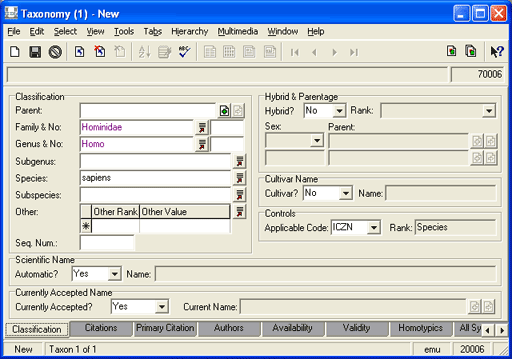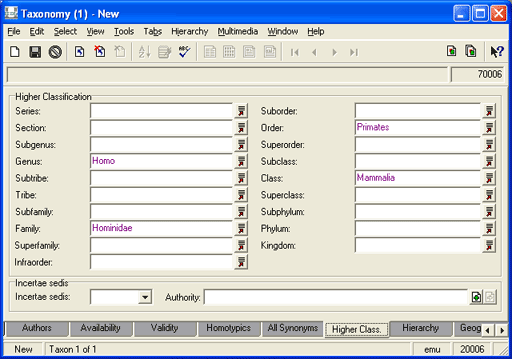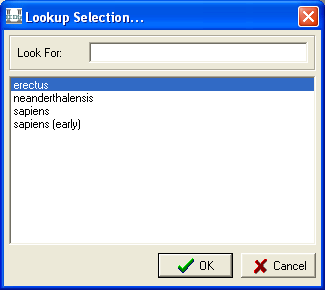From the Greek taxis, meaning arrangement, order, and nomos, meaning law, science, Taxonomy is the science, laws and principles of classification. While almost anything can be classified, the EMu Taxonomy module is intended for recording details about the scientific name - the classification - of organisms: plants and animals.
Owing much to the work of Carolus Linnaeus (1707-1778), modern taxonomies of plants and animals are a practical approach to ordering and naming groups of organisms in logical hierarchical structures. The Linnaean system specifies seven major categories for organisms:
- Kingdom
- Phylum in Zoology or Division in Botany
- Class
- Order
- Family
- Genus
- Species
Note: Sub-divisions within these categories, such as subclass and superfamily also exist. In EMu over twenty categories or ranks are available.
Classification entails identifying similarity between organisms as well as evolutionary descent until a point of uniqueness can be identified. Thus many organisms belong to the same kingdom, fewer to the same phylum, fewer still to the same class, and so on. What emerges is a series of parent-child relationships that ends with a species, a unique group of closely related organisms that are able to interbreed and produce fertile offspring.
Categories higher than kingdom (organism and domain) are typically omitted in the standard description of an organism, and in most cases listing the lower level categories (family, genus and species) is sufficient to imply the higher level categories. When recording a scientific name in EMu, Lookup Lists are filtered and fields auto-filled depending on the selection of values in other fields. For instance, selecting sapiens in the Species field will auto-fill the Genus and Family fields with Homo and Hominidae respectively.
Two standard EMu Lookup List features are worth mentioning here for the assistance they provide when working with Taxonomy records. Two or more Lookup List fields can be linked in EMu in a logical hierarchy, where selection of one value implies another (one or more).
For instance, selecting sapiens from the Species: (Classification) Lookup List on the Classification tab, automatically completes the Genus & No: (Classification) and Family & No: (Classification) values:

If we now select the Higher Class. tab, we find that not only have these categories been completed, several others have also been auto-filled:

Auto-fill operates by filtering Lookup Lists depending on values entered elsewhere in the Lookup List hierarchy. In the case of sapiens in the Species: (Classification) Lookup List, only one value is possible in the Genus & No: (Classification) and Family & No: (Classification) fields. If however, Homo were entered in the Genus & No: (Classification) field, the Family & No: (Classification) field is automatically populated with Hominidae but the Species: (Classification) field is not completed - there is more than one possible species in the HominidaeHomo classification. Nonetheless, the Species: (Classification) Lookup List is filtered to only those values which are possible, making selection of the correct value far simpler than searching a massive list:

Note: Lookup Lists are constructed as data is entered into EMu; they can be maintained using the Lookup Lists module.
The naming of a species is governed by strict rules:
- The name must be Latin, unique and binomial (a combination of the genus and species names).
- The name must be published in a well respected, preferably international, scientific journal.
- The publication must include a description of the new species.
- The description must be based on a type specimen that is accessible to other scientists.
An EMu Taxonomy record manages all of this detail. Furthermore, different rules apply to the construction of the scientific name of zoological and botanical species and EMu will take user input (genus, species, author name, citations, date, etc.) and generate the appropriate format depending on the rule set specified (ICBN or ICZN).
Rules have been devised for the publication, validation and documentation of scientific names in order to ensure a unique name for every taxon. In defining taxonomic names for organisms, two primary sets of rules apply, depending on whether the species is zoological or botanical:
- International Code of Zoological Nomenclature (ICZN)
- International Code of Botanical Nomenclature (ICBN)
While there are many similarities between the two, there are some important differences. For instance:
- According to the rules of ICZN, when a species is combined with a different genus, the name of the author of this new combination is not included in the scientific name. However, according to the rules of the ICBN the combination authors are included. For example:
- According to the ICBN the Taxonomic name Cucamis chysocomus Shumacher, (1827) becomes Rhaphiodiocystis chrysocoma (Schumacher) C. Jeffrey (1962).
- According to the ICZN the taxonomic name Bothynoproctus portai Straneo, 1941 becomes Neotalis portai (Straneo, 1941).
- Tautonyms are allowed in the ICZN but not ICBN (e.g. Bison (Bison) bison bison is an available name according to the ICZN).
- In the ICZN the higher levels of the classification hierarchy are: Kingdom>Phylum>Subphylum.
- In the ICBN the higher levels of the classification hierarchy are: Kingdom>Division>Subdivision.
(Reference: Principles of Phylogenetics, Integrative Biology 200A, 9 March 2006, University of California, Berkeley)
These rules are encoded in EMu and it is a simple matter to conform to either set by selecting ICBN or ICZN from the Applicable Code: (Controls) drop list on the Classification tab:

Note:
Either value can be set as the default for an organi
While most of the differences are not immediately apparent when a rule set is selected, the difference between the zoological and botanical classification hierarchy is evident on the Higher Class. tab:
- The ICBN hierarchy is:

- The ICZN hierarchy is:

Although less obvious, the differences between the rule sets are apparent when values are entered into a taxonomic record, for instance, in the way that a Parenthetic Author![]() In Taxonomy, the author of a paper that challenges an existing taxon. is handled. See How to record a Parenthetic Author for details.
In Taxonomy, the author of a paper that challenges an existing taxon. is handled. See How to record a Parenthetic Author for details.
